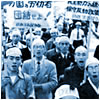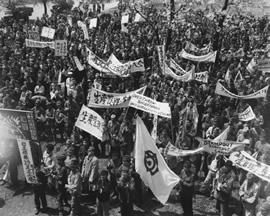Learn About Japan > Work and Workplaces in Japan > Labor Unions > Labor Strikes and Production Control

|

Labor Unions
- Rapid Rise of Labor Unions in Japan from 1945
- Postwar Japan's first Labor Laws
- Labor Strikes and Production Control
- Bloody May Day (May 1, 1952)
- Formation of Sōhyō (Japan General Council of Trade Unions)
- The Rise and Fall of Radical Union Activity
- Enterprise Unions in Japan
- The Miike Mine Strike
- Strikes Japanese-Style
- Who Can Strike in Japan
- Kinds of Strikes in Japan
- The Spring Labor Offensive (Shuntō)
- Enterprise Union Cooperation
- Privatization of Japan National Railway
- Rengō and the Merger of Japanese Labor Federations
|

Japanese workers demonstrate for production control on April 12, 1946. Many of the banners say "seisan kanri" or production control.
Photo from Mainichi Shimbun.
Labor Strikes and Production Control
In 1945-46 economic conditions were severe and food was in short supply. Many companies shut down production or laid off workers who desperately needed their jobs. But at the same time, workers felt newly empowered to demand better working conditions and status. The result was a steady rise in labor strikes and slowdowns.
When negotiations with management failed, the workers in some factories engaged in “production control” (seisan kanri) by locking out the managers and running the factories by themselves. Production control spread to over 200 mines, factories, railways, and even government offices in the first half of 1946.
Click on CHARTS, below, for more information about labor disputes in 1946 and 1947.
|
Special Terms:
strike
|
| Download Podcast in
English
| Japanese
|
|
Document |
Audio-Video |
Chart |
Picture |
Map
|
|

